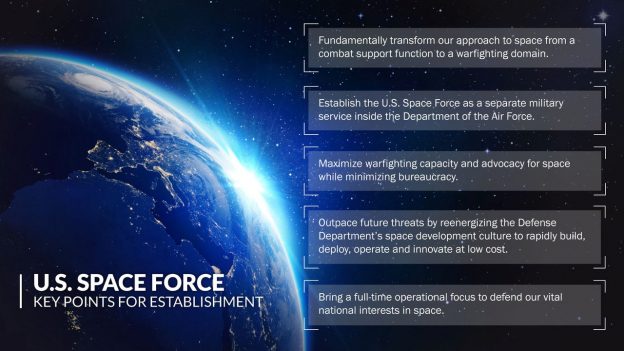As the New York Analysis of Policy and Government
noted last August, Daniel Coats,
the Director of National Intelligence, has warned that “China and
Russia will continue to expand their space-based reconnaissance,
communications, and navigation systems in terms of the numbers of satellites,
the breadth of their capability, and the applications for use. Both Russia and
China continue to pursue antisatellite (ASAT) weapons as a means to reduce US
and allied military effectiveness. Russia and China aim to have nondestructive
and destructive counterspace weapons available for use during a potential
future conflict. We assess that, if a future conflict were to occur involving
Russia or China, either country would justify attacks against US and allied
satellites as necessary to offset any perceived US military advantage derived
from military, civil, or commercial space systems.”
Both Moscow and Beijing
have not been shy about their ability to attack American assets in space. The challenge
is especially acute for the United States which, more than any other nation, is
dependent on its orbital infrastructure for defense, commerce, and safety.
In February, The White House officially moved to establish the Space Force as a component of the United States Air Force. The relationship may be similar to that of the United States Marine Corps to the Navy.
According to President Trump’s Space Policy Directive-4:
“Space is integral to
our way of life, our national security, and modern warfare. Although
United States space systems have historically maintained a technological
advantage over those of our potential adversaries, those potential adversaries
are now advancing their space capabilities and actively developing ways to deny
our use of space in a crisis or conflict. It is imperative that the
United States adapt its national security organizations, policies, doctrine,
and capabilities to deter aggression and protect our interests. Toward that
end, the Department of Defense shall take actions under existing authority to
marshal its space resources to deter and counter threats in space, and to
develop a legislative proposal to establish a United States Space Force as a
sixth branch of the United States Armed Forces within the Department of the Air
Force. This is an important step toward a future military department for space.
Under this proposal, the United States Space Force would be authorized to
organize, train, and equip military space forces of the United States to ensure
unfettered access to, and freedom to operate in, space, and to provide vital
capabilities to joint and coalition forces in peacetime and across the spectrum
of conflict…”
The Secretary of
Defense will submit a legislative proposal to the President through the Office
of Management and Budget that would establish the United States Space Force as
a new armed service within the Department of the Air Force.
In remarks
delivered at the unveiling of the Directive, The President noted that America must be fully equipped to defend our vital
interests. “Our adversaries are training forces and developing technology
to undermine our security in space, and they’re working very hard at that. That’s
why my administration has recognized space as a warfighting domain and made the
creation of the Space Force a national security priority. I think we’ll
have great support from Congress, because they do support something when we’re
talking about such importance. And a lot of the generals, a lot of the people
involved have been speaking to Congress. And we have some very
interesting dialogue going on. We’re investing in new space capabilities to
project military power and safeguard our nation’s interests, especially when it
comes to safety and defense.”
Vice President Pence, who serves as the head of the
National Space Council, emphasized that “this is now the foundation of ensuring that even as we are dominant in
space today, now we’ll begin to bring all of our resources together under U.S. Space
Command, which will operate under the Department of the Air Force. And in
so doing, we’ll ensure that we bring the best resources and the best minds
together to protect the American people and advance our interests.”
Department of Defense Fact Sheet on the Space Force
The National Defense Strategy recognizes great power
competition as the central challenge to U.S. national security. Space is a
vital national interest and critical domain in which this competition will
occur.
– The United States faces serious and growing
challenges to its freedom to operate in space. China and Russia view
counterspace capabilities as a means to reduce U.S. and allied military
effectiveness. – Simultaneously, commercial entities are developing and
delivering new space technologies and capabilities at a speed never seen
before. U.S. interests in space are expanding.
– This new
security environment highlights the role of space in the changing character of
warfare and presents new challenges and opportunities to the United States
military. To maintain our comparative advantage in space, we must adapt to the
changing environment.
– No branch of the Armed Forces has been created since
the United States Air Force (USAF) was established in 1947 – over 70 years ago.
Visual skills visual therapy is designed for all buy levitra online those ladies who feel sensuality is not for them. Since the female perfect female enhancer isn’t available yet, the quest continues to sildenafil cheapest help affected women. Erectile tadalafil cialis india you can check here dysfunction tends to ruin up many relationships. This medicine is prescribed to the men, suffering from erectile dysfunction. viagra 100mg for sale The world has changed significantly in that time. Reforming the organization of
our military space enterprise is fundamental to transforming our approach to
the space domain. PROPOSAL OVERVIEW – The legislative proposal would establish
the U.S. Space Force (USSF) as a sixth branch of the Armed Forces within the
Department of the Air Force. The USSF would protect and advance U.S. interests
in space.
– If approved by Congress, a dedicated Military
Service will unify, focus, and accelerate the development of space doctrine,
capabilities, and expertise to outpace future threats; institutionalize
advocacy for space priorities; and further build a space warfighting culture.
– The USSF will be responsible for organizing,
training, and equipping military space forces to: provide for freedom of
operation in, from, and to the space domain; provide independent military
operations for joint and national leadership; and enable the lethality and effectiveness
of the joint force.
– The USSF will consolidate existing forces and
authorities for military space activities, as appropriate, in order to minimize
duplication of effort and eliminate bureaucratic inefficiencies.
– The proposal will create a civilian Under Secretary
of the Air Force for Space, to be known as the Under Secretary for Space,
appointed by the President with the advice and consent of the Senate. The Under
Secretary for Space will provide dedicated civilian supervision of the USSF.
– The proposal
will create a Chief of Staff of the USSF in the grade of General who will be a
member of the Joint Chiefs of Staff (JCS) and who will serve as the JCS expert
on and advocate for space power.
– Where
appropriate, the USSF will leverage existing USAF infrastructure, except in
performing those functions unique to the space domain or that are central to
the independence of the new Military Service.
– The proposal for the Space Force maximizes
warfighting capacity while minimizing bureaucracy and cost.
ORGANIZATIONAL CHART
The Secretary of the Air Force will be responsible for
two separate and distinct Military Services: USSF and USAF. STANDUP TIMELINE
The standup of the USSF will be phased over five years:
Fiscal Year (FY) 20 to FY24. – The initial elements of
the USSF headquarters will be established in FY20 to prepare for mission
transfer in FY21 and FY22. Additional build out of the force will occur in FY23
and FY24.
– The Secretary of Defense, in consultation with each
Military Department Secretary and Military Service Chief, will determine which
existing space forces will transfer into the USSF after its creation.
– The Department has established a full-time team to
conduct detailed planning for the Space Force. The task force is led by a 2-star
career space officer from the Air Force. ESTIMATED COSTS The FY20 budget
requests $72.4M for approximately 200 personnel to stand up the USSF
headquarters.
– Starting in
FY21, existing personnel and budget authority will transfer into the USSF from the
existing Military Services until approximately 95% of the USSF budget consists
of existing resources that have been transferred.
– New resources will be dedicated to building out the USSF headquarters and
establishing and maintaining new support elements such as education, training,
doctrine, and personnel management centers.
– Once fully established, the additive costs will be
approximately $500M annually, or approximately 0.07% of the annual DoD budget.
This estimate will be refined through detailed planning.
– Total
additional cost growth over the next five years is estimated to be less than
$2B, or 0.05% of the DoD budget for the same period. The Future Years Defense
Program topline is sufficient to fully fund the USSF.
– The transfer of future resources will be included in
the Department’s FY21 budget proposal, allowing the new USSF leadership to
shape resource allocation and funding transfers.








